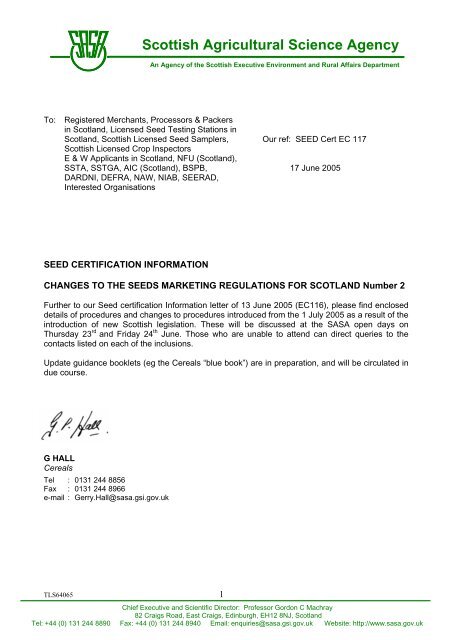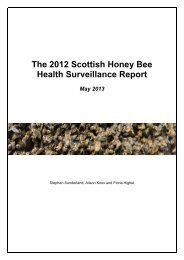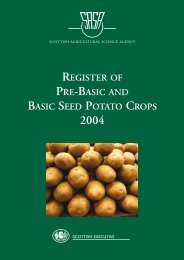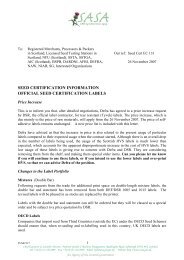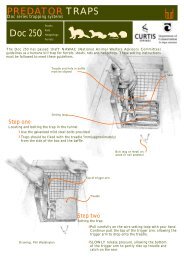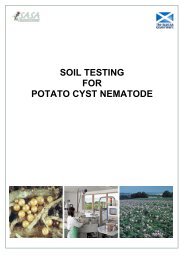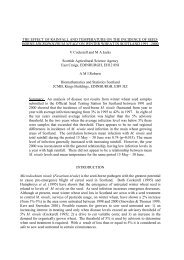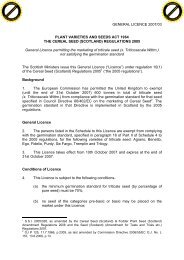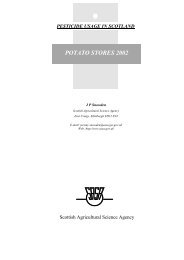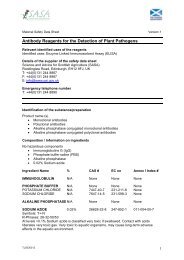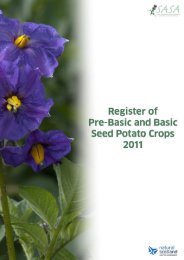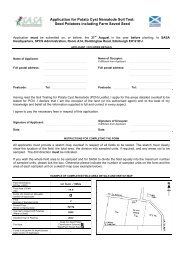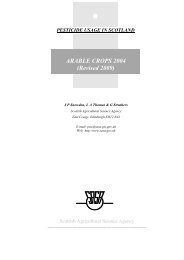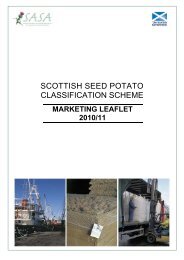Seed Certification Letter 117 - SASA
Seed Certification Letter 117 - SASA
Seed Certification Letter 117 - SASA
Create successful ePaper yourself
Turn your PDF publications into a flip-book with our unique Google optimized e-Paper software.
Scottish Agricultural Science AgencyAn Agency of the Scottish Executive Environment and Rural Affairs DepartmentTo: Registered Merchants, Processors & Packersin Scotland, Licensed <strong>Seed</strong> Testing Stations inScotland, Scottish Licensed <strong>Seed</strong> Samplers, Our ref: SEED Cert EC <strong>117</strong>Scottish Licensed Crop InspectorsE & W Applicants in Scotland, NFU (Scotland),SSTA, SSTGA, AIC (Scotland), BSPB, 17 June 2005DARDNI, DEFRA, NAW, NIAB, SEERAD,Interested OrganisationsSEED CERTIFICATION INFORMATIONCHANGES TO THE SEEDS MARKETING REGULATIONS FOR SCOTLAND Number 2Further to our <strong>Seed</strong> certification Information letter of 13 June 2005 (EC116), please find encloseddetails of procedures and changes to procedures introduced from the 1 July 2005 as a result of theintroduction of new Scottish legislation. These will be discussed at the <strong>SASA</strong> open days onThursday 23 rd and Friday 24 th June. Those who are unable to attend can direct queries to thecontacts listed on each of the inclusions.Update guidance booklets (eg the Cereals “blue book”) are in preparation, and will be circulated indue course.G HALLCerealsTel : 0131 244 8856Fax : 0131 244 8966e-mail : Gerry.Hall@sasa.gsi.gov.ukTLS64065 1Chief Executive and Scientific Director: Professor Gordon C Machray82 Craigs Road, East Craigs, Edinburgh, EH12 8NJ, ScotlandTel: +44 (0) 131 244 8890 Fax: +44 (0) 131 244 8940 Email: enquiries@sasa.gsi.gov.uk Website: http://www.sasa.gov.uk
CONTROL PLOTSThe Oil and Fibre Plant <strong>Seed</strong> (Scotland) Regulations 2004, the Cereal <strong>Seed</strong> (Scotland)Regulations 2005 and the Fodder Plant <strong>Seed</strong> (Scotland) Regulations 2005 (collectivelyreferred to as “the Regulations”) come into force on 1 July 2005. The Regulations changethe requirements relating to control plots.For a licensed inspection to be used for seed certification an official control plot will berequired for each seed lot, and the plants produced in the control plot will have to pass anofficial examination for the minimum EC standard (not HVS) for which the crop is entered. Inthe absence of a control plot, any inspection will have to be official. Scottish Ministers willrecognise control plots sown in other areas of the United Kingdom, provided confirmation ofthis fact and the result is given to Scottish Ministers. If you are uncertain that a control plothas been sown in other areas of the United Kingdom, you may wish to send a plot sample ofeach seed lot you intend to enter for crop production in Scotland to <strong>SASA</strong>.Additionally, if a seed lot fails the minimum EC standard (not HVS) for varietal purity in postcontrol, licensed inspections will not be allowed on any crops sown with such a seed lot, andofficial inspections will have to take place. For example, a licensed inspection will be allowedto take place on C1H seed lot that fails the C1H standards in post control, but if this seed lotwere also to fail C1L in post control, a licensed inspection will not be allowed, and an officialinspection will be required.For Information contact:Cereals:Gerry Hall - Telephone: 0131 244 8856; E-Mail Gerry.Hall@sasa.gsi.gov.ukFiona McKay - Telephone: 0131 244 8927; E-Mail Fiona.McKay@sasa.gsi.gov.ukNon Cereals:Ken Pearson, Tel: 0131 244 8885, e-mail: Ken.Pearson@sasa.gsi.gov.ukRussell Thomson, Tel: 0131 244 8899, e-mail: Russell.Thomson@sasa.gsi.gov.ukTLS33065 2
SAMPLING FOR MOISTURE CONTENT DETERMINATIONThe Cereal <strong>Seed</strong> (Scotland) Regulations 2005, which come into force on 1 July 2005,require moisture content to be carried out on seed being certified and marketed.Primary samples for moisture tests should be taken in such a way as to minimise exposureto the atmosphere. The sample submitted to a licensed seeds laboratory or the OSTS mustbe in a moisture proof container, of a type approved by the Certifying Authority. A sample ofat least 100 gms is required.The following are examples of containers that can be used for submitting moisture samples:Resealable plastic bagsFoil & polythene bags that can be heat-sealedGlass or polythene bottles with an airtight topThe following method is used to obtain a submitted sample from a composite sample:The composite sample is passed through a Riffle Divider once.A moisture proof container is drawn/pulled randomly through the seed obtained in one of thetwo collecting vessels.The container is then sealed, after excluding as much air as possible, placed in the samplebag and submitted to the seeds laboratory as soon as possible.Alternatively, the whole composite sample may be submitted in a moisture proof container.For further information please contact:Ken Pearson, Tel: 0131 244 8885, e-mail: Ken.Pearson@sasa.gsi.gov.uk orRussell Thomson, Tel: 0131 244 8899, e-mail: Russell.Thomson@sasa.gsi.gov.ukTLS33065 3
Registration of Fodder MixturesThe Fodder Plant <strong>Seed</strong> (Scotland) Regulations 2005, which come into force on 1 July 2005,require certain information to be provided to the Certifying Authority (<strong>SASA</strong>) when the detailsof a mixture are not contained on a label.If a mixture is always labelled with labels which contain the percentage by weight ofeach of the constituents by species and, where appropriate, by variety, there is noneed to register the mixture with the Certifying Authority.When a brand name only is used on the mixture label, a company must provide <strong>SASA</strong> withthe name of the mixture, details of all the constituents and their proportions by weight. Thereis currently no fee for registration, which is valid for one year from the date of approval. Oncea mixture has been registered, <strong>SASA</strong> must be informed of any changes to the mixture nameor the constituents.Packages over 10kg (Agricultural or Amenity Mixtures)Once a mixture has been registered, details of species/variety/percentage by weight can beomitted from the official label. The customer must, however, be provided, at or before thesale, with a despatch note or invoice, which includes the details omitted from the officiallabel.Small EC "A" Packages (up to and including 2kg - Amenity Mixtures)Small EC "B" Packages (above 2kg up to and including 10kg - Agricultural or AmenityMixtures)Even after a mixture has been registered, only the details of the percentage by weight of theconstituents can be omitted from the label. The label must continue to include the speciesand variety names of all the constituents. The customer must also be informed, at or beforethe sale, that information relating to the percentage by weight of each of the constituents inthe mixture will be provided by the supplier on request.The registration of a mixture only permits the information detailed above to beomitted from the label. It does not affect any of the other packaging or labellingrequirements set out in The Fodder Plant <strong>Seed</strong> (Scotland) Regulations 2005.Details of mixtures should be sent to Ken Pearson at <strong>SASA</strong> or e-mailed toKen.Pearson@sasa.gsi.gov.uk.TLS33065 4
MOISTURE CONTENT TESTINGThe Cereal <strong>Seed</strong> (Scotland) Regulations 2005 (“the Regulations”) come into force on 1 July2005. The Regulations set 17% as the maximum moisture content of cereals and willrequire moisture content tests to be carried out on all cereal seed lots entered for<strong>Certification</strong>. Moisture Content tests will be carried out by either the Official <strong>Seed</strong> TestingStation (OSTS) or Licensed <strong>Seed</strong> Testing Stations (LSTSs).<strong>Seed</strong> treatments applied as aqueous suspensions have a significant affect on seedmoisture content and processors should ensure that seed meets the moisture contentstandard after the application of such treatments and prior to processing.When sampling a seed lot for certification purposes, the sampler should draw the moisturesample in such a way as to minimise exposure of the sample to the atmosphere. There aretwo options available for submitting the moisture content sample.Option 1The seed lot is sampled in the usual way and the complete composite sample is submitted tothe seed testing station in an airtight container.For samples tested at LSTSs the weight of the composite sample must be at least 2.25kg;for samples to be tested at the OSTS the weight of the composite sample must be at least1.25kg.Option 2The composite sample is passed through a riffle/soil divider once and a moisture proofcontainer is filled by drawing it through the seed contained in one of the tins. The containeris then sealed and the remainder of the composite sample mixed and divided as detailed inthe Regulations to give a submitted sample of at least 2kg, for LSTSs, or 1kg, for the OSTS.The moisture sample is placed inside the sample bag with the certification sample. In thisway, the seed for moisture content tests are separate from the rest of the seed in the samplebag on which the other certification tests have to be carried out. Those using the OSTS totest certification samples will be provided with moisture proof containers that can beused to submit moisture samples in this way.Using both Options 1 and 2 the samples must be submitted for testing as soon as possible.<strong>Seed</strong> testing stations must complete moisture content tests within 5 days of the seed lotbeing sampled or the test will be considered invalid and another moisture content sample willbe required.There are two methods of determining the moisture content of cereals included in theInternational <strong>Seed</strong> Testing Association (ISTA) Rules. These are:the high¬ constant temperature oven method; andthe moisture¬ meter method.For both methods the equipment used must be approved by the OSTS before MoistureContent Testing is added to the license of a LSTS. For those using the meter method, themeter must be calibrated for each species tested. New calibrations are required each time atotal of 100 samples are tested. The maximum time allowed between calibrations is 12months.TLS33065 5
Monitoring of this test will be carried out by the OSTS during audit visits to LSTSs. It willinclude:duplicate tests¬ on the day of the audit visit; andproficiency¬ tests on the day of the audit using samples of known moisture content.For LSTSs using the moisture meter method there will be additional checks on calibrationtest data and of the logbook containing details of number of tests carried out.If you have any questions please contact:For Information on Procedures for obtaining Moisture Content samples:Ken Pearson - Telephone: 0131 244 8885; E-Mail Ken.Pearson@sasa.gsi.gov.ukFor information on Moisture Content testing and the provision of moistureproof containers for submission of samples to the OSTS for testing:Caroline Cadger-Telephone: 0131 244 8908; E-Mail Caroline.Cadger@sasa.gsi.gov.ukorJean Hall – Telephone: 0131 244 8803; E-Mail Jean.Hall@sasa.gsi.gov.ukFor information on calibration of Moisture Meters:Ronald Don – Telephone 0131 244 8891; E-Mail Ronald.Don@sasa.gsi.gov.ukorGillian McLaren-Telephone: 0131 244 8851; E-Mail Gillian.McLaren@sasa.gsi.gov.ukTLS33065 6
TETRAZOLIUM TESTINGThe Cereal <strong>Seed</strong> (Scotland) Regulations 2005 (“the Regulations”) come into force on 1 July2005. The Regulations will allow the use of a tetrazolium test on all categories of certifiedcereals as an alternative to the full germination test. This will enable seed to be marketedrapidly. Tetrazolium tests will be carried out by either the Official <strong>Seed</strong> Testing Station(OSTS) or Licensed <strong>Seed</strong> Testing Stations (LSTSs) that have been approved to carry outsuch tests.The relationship between tetrazolium and germination is very good; however, in somecircumstances the tetrazolium test will give an over-estimation. For example, the tetrazoliumtest does not detect the effects on germination of:• chemicals; or• seed-borne diseases.In addition, in seed lots where drying damage is present the germination of such lots isinvariably lower than that indicated by the test.For these reasons certification will not be permitted by tetrazolium testing if:• heat damage is present; or• the seed crop was treated with glyphosate.Furthermore, tetrazolium testing is only available for seed lots of wheat and oats that are tobe sold untreated when a disease test demonstrates that the combined levels ofMicrodochium and/or Septoria are less than 10%.The result of a tetrazolium test will be reported as a percentage of viable seeds and thenumber of seed tested must also be reported. This is important because based on statisticalprobabilities there are different pass percentages depending on the number of seeds tested.For example:‣ 100 seeds tested: 93% and above viable = pass, otherwise fail.‣ 200 seeds tested: 90% and above viable = pass, otherwise fail.‣ 400 seeds tested: 85% viable and above = pass, otherwise fail.It will be the responsibility of the applicant to ensure seed submitted for tetrazolium meetsthe conditions for this test. <strong>Seed</strong> tested by tetrazolium that is subsequently found not tohave met testing criteria is deemed not to have been certified. A germination test must becarried out if there is any doubt about whether a tetrazolium test is applicable.The results of a germination test will always take precedence over those of atetrazolium test and enforcement and certification control will be based ongermination.If you have any questions please contact:For Information on <strong>Certification</strong> procedures using Tetrazolium testingGerry Hall - Telephone: 0131 244 8856; E-Mail Gerry.Hall@sasa.gsi.gov.uk orBob Sunter - Telephone: 0131 244 8815; E-Mail Bob.Sunter@sasa.gsi.gov.ukFor information on Tetrazolium testing:Caroline Cadger - Telephone: 0131 244 8908; E-Mail Caroline.Cadger@sasa.gsi.gov.ukorGillian McLaren - Telephone: 0131 244 8851; E-MailGillian.McLaren@sasa.gsi.gov.ukTLS33065 7
- name and address of the first buyer by way of trade;- the date on which the preliminary test of germination was carried outand of the date of the provisional germination report;- the result of the preliminary test of germination; and- if appropriate, the date on which the first buyer by way of trade wasinformed of the result of the completed official germination test.The “Early Movement” provision only applies to seed sold to the first buyer by way oftrade. The first buyer by way of trade must be another seed merchant. Furthermarketing beyond the first buyer by way of trade before the completion of the officialgermination test is prohibited.The requirements apply to all seed marketed in Scotland, including seed originatingfrom England.In the event of the official germination test showing the failure of the seed to comply with therelevant germination standard, the supplier must notify the buyer of the specific percentageof germination ascertained, in writing. That notification must be made as soon aspracticable and in any event no later than 7 days after the supplier was informed of theresult.In order to make seed covered by the Cereal <strong>Seed</strong> (Scotland) Regulations 2005 morerapidly available to farmers, a Statutory Tetrazolium Test (STZ Test) has beenintroduced for all species and for each generation. A germination test will not benecessary where a seed lot is tested using the STZ test. <strong>Seed</strong> lots that are to bemarketed using the STZ test will not be eligible for early movement, but once the testis completed and the result is satisfactory, the seed lot can be marketed to any buyer.There are some restrictions to the use of this test. <strong>Certification</strong> will not be permitted bytetrazolium testing if:• heat damage is present; or• the seed crop was treated with glyphosate.In addition, tetrazolium testing is only available for seed lots of wheat and oats that are to besold untreated, when a disease test demonstrates that the combined levels of Microdochiumand/or[KJ1] Septoria are less than 10%.A germination test must be carried out if there is any doubt about whether a tetrazolium testis applicable.Suppliers should familiarise themselves with the separate written guidance available from<strong>SASA</strong> in respect of Statutory Tetrazolium Testing.For Information on <strong>Certification</strong> procedures:Cereals:Gerry Hall - Telephone: 0131 244 8856; E-Mail Gerry.Hall@sasa.gsi.gov.ukBob Sunter - Telephone: 0131 244 8815; E-Mail Bob.Sunter@sasa.gsi.gov.ukNon Cereals:Ken Pearson, Tel: 0131 244 8885, e-mail: Ken.Pearson@sasa.gsi.gov.ukRussell Thomson, Tel: 0131 244 8899, e-mail: Russell.Thomson@sasa.gsi.gov.ukTLS33065 9
DETAILED PROCEDURES FOR THE DETERMINATION OFMOISTURE CONTENT OF CEREAL SEED1. ISTA HIGH CONSTANT TEMPERATURE OVEN METHODAPPARATUS REQUIREDOvenAn oven capable of maintaining a temperature of 130±2 o C. The temperature variationbetween the various locations within the oven must be within ±2 o C. The heating capacity ofthe oven must be such that, after preheating to the required temperature followed byopening and loading with containers, the oven will again reach the required temperaturewithin 15 minutes.Thermometer/ThermocoupleThe instrument used to monitor temperature must be accurate to ±0.5 o C.ContainersThese must be of non-corrosive metal or glass of approximately 0.5mm thickness and havelids. They should be between 6cm and 8cm diameter and have a depth of 1.5cm.Grinding MillThe mill used must grind evenly and in a manner that does not cause heating. At least 50%of the ground material must pass through a wire sieve of 0.50mm and not more than 10%remain on a wire sieve of 1.00mm.BalanceAn analytical balance capable of weighing accurately to 0.001g.DesiccatorThis should be fitted with a thick metal plate to promote rapid cooling of containers. Asuitable desiccant should used.HEALTH and SAFETYAppropriate measures must be taken to ensure compliance with regulations inrespect to dust, chemical, seed treatments, electrical equipment and hightemperatures.METHOD1. The oven is switched on prior to starting tests to allow it to reach the requiredtemperature of 130± 2 o C.2. Before drawing working samples the submitted sample must be thoroughly mixed by oneof the following methods that minimises exposure of the sample to the air:• Stir the sample in its container with a spoon/scoop; orTLS33065 10
• Place the opening of the original container against the opening of a similar containerand pour the seeds back and forth between the two containers.3. Two independently drawn replicates are used to determine the moisture content.Each replicate must be drawn in such a manner that the sample is not exposed tothe air for more than 30 seconds.Each replicate is obtained by grinding a representative sample of the thoroughly mixedsubmitted sample.• If the complete certification sample has been submitted in a moisture proofcontainer:A spoon/scoop is placed in the container and small portions removed from different positionsand ground. This is repeated until about 4 – 5g of ground material is obtained. Theground portion is weighed to 3 decimal places in a pre-weighed container whose lid isplaced under the container for weighing. The sample is then immediately coveredwith the lid.• If the sample is in a moisture bottle:Small amounts of seed are removed and ground until the required amount of ground seed isobtained. This is repeated until about 4 – 5g of ground material is obtained. Theground portion is weighed to 3 decimal places in a pre-weighed container whose lid isplaced under the container for weighing. The sample is then immediately coveredwith the lid.In both cases two independently drawn replicates are required.4. The containers are placed in the oven (with their lids removed and underneath) asquickly as possible to reduce exposure to the air. The time is noted.5. Fifteen minutes after placing containers in the oven the temperature is noted. This mustbe 130± 2 o C.6. The samples remain in the oven for a further 2 hours.7. The containers are removed from the oven and placed in a desiccator, with their lids inplace, to cool for 30 – 45 minutes.8. The containers and dried contents are weighed and the moisture content is calculated.CALCULATION OF RESULTSThe moisture content is expressed as a percentage by fresh weight. It is calculated to onedecimal place using the following formula:where:(M 2 – M 3 )------------- x 100(M 2 -M 1 )M 1 = the weight in grams of the container and its cover.M 2 = the weight in grams of the container, its cover and its contents before drying.M 3 = the weight in grams of the container, its cover and its contents after drying.TLS33065 11
The moisture content of each replicate is calculated and recorded. If the difference betweenthe two replicates does not exceed 0.2%, the result reported is the arithmetic mean. This isexpressed to one decimal place. If the difference is greater than 0.2% the replicate resultsare out of tolerance and the determination must be repeated.PRE-DRYINGIf a moisture content result of more than 17% is obtained, a retest is obligatory involving apre-drying stage prior to grinding the seed for the ISTA high constant temperature ovenmethod.The pre-drying stage involves:1. Two independently drawn replicates are used to determine the moisture content.Each replicate must be drawn in such a manner that the sample is not exposed tothe air for more than 30 seconds.• If the complete certification sample has been submitted in a moisture proofcontainer:A spoon/scoop is placed in the container and small portions removed from differentpositions. This is repeated until 25±1g of seed is obtained. The seed is weighed to 1decimal place in a pre-weighed container.• If the sample is in a moisture bottle:Small amounts of seed are removed until 25±1g of seed is obtained. The seed is weighed to1 decimal place in a pre-weighed container.In both cases two independently drawn replicates are required.2. The seed in their containers is placed in an oven at 130±2 o C for 5-10 minutes. The partlydried seed is then removed from the oven and allowed to cool in the laboratory for2 hours.3. After the 2 hour cooling and equilibration period the seed is re-weighed in the containers.4. Immediately thereafter the seed is subject to the ISTA high constant temperature ovenmethod, as described earlier.CALCULATION OF RESULTThe moisture content is expressed as a percentage by fresh weight. It is calculated to onedecimal place using the following equations:where:(W 2 – W 3 )S 1 = ------------- x 100 --------------------------equation 1(W 2 - W 1 )S 1 = moisture content lost during pre-dryingW 1 = weight of containerW 2 = weight of the container + seedW 3 = weight of the container + pre-dried seedTLS33065 12
(Note that W 2 – weight of the ground seed must be 25±1g)TLS33065 13
Moisture proof containersFor storing calibration samples.Refrigerated StorageFor storing calibration samples at 5±2 o C for up to 10 days.Apparatus as detailed for ISTA high constant temperature oven method “the referencemethod”.Calibration SamplesFive calibration samples are required. These must come from a minimum of two varieties ofthe species for which the moisture meter is being calibrated. The samples should have arange of moisture contents evenly covering the required measurement range for which themoisture meter is being checked. The range covered must include moisture contents up to18%, if the meter is to be used for certification tests.METHOD1. The calibration of moisture meters may be affected by many variables, including species,variety, ripeness, humidity, temperature and level of impurities. To minimise theseeffects:• Calibration samples should have an analytical purity of at least 98%;• During determinations, exposure of samples to the atmosphere must be reducedto the absolute minimum;• A minimum of 2 varieties of each of the species for which moisture meter is beingcalibrated must be used;• Calibration samples are stored at 5±2 o C;• Calibration samples must be used within 10 days of preparation;• Prior to use, calibration samples must be equilibrated to the same temperature asthe moisture meter;• Calibration samples should be free of mustiness, fermentation and sproutedseed;• The calibration samples must be thoroughly mixed, before working samples aredrawn from them using one of the following methods:‣ Stir the sample in its container with a spoon/scoop; or‣ Place the opening of the original container against the opening of a similarcontainer and pour the seeds back and forth between the two containers.2. Each working sample must be drawn in such a manner that it is not exposed to the air formore than 30 seconds.3. The moisture content of the calibration samples is determined using the referencemethod.4. Three successive measurements are made on each calibration sample using themoisture meter according to the manufacturer’s instructions.TLS33065 16
5. After drawing each sample, for either oven or meter determination, the calibrationsample must be thoroughly mixed prior to drawing the next working sample.6. After the completion of moisture meter tests the moisture content of the calibrationsamples are re-checked using the reference method.CALCULATION OF RESULTSReference oven methodFor each calibration sample there are two results; x 1 obtained before measuring the moisturecontent with the moisture meter, and x 2 obtained after measuring the moisture content withthe moisture meter. The average of x 1 and x 2 is the true value of the moisture contentprovided the difference between x 1 and x 2 is no greater than 0.3%. If the difference isgreater than 0.3% the calibration must be repeated.Moisture meterFor each calibration sample there are three results and these should be designated as y 1 , y 2and y 3 .Calculate the average of the three values as y x (y x = (y 1 + y 2 + y 3 )/3). Subtract y x from thetrue value of the moisture content and designate the result as z i .A moisture meter is considered to be within calibration when z i is lower than the followingmaximum permissible errors.True value of the moisture content(reference method)Less than 10% ±0.4%Maximal permissible error10% or more ±0.04 x true value moisture contentTLS33065 17
APPENDIXEXAMPLE OF CALCULATION WHEN PRE-DRYING IS REQUIRED FOR THE MOISTURECONTENT TEST PROCEDUREMOISTURE CONTENT TESTMOISTURE QACHECKS/DATEPre -Drying Required Test 1RD 20/2/05Sample No.: 123 Test 2MOISTURETESTRESULT20.5%Test date: 20/2/03 Analyst GM Checked: RD Test date: Analyst:Checked:TEST 1 Pre -DryingTEST 2 Pre-DryingBEFORE DRYING TIN ( d ) TIN ( f ) BEFORE DRYING TIN ( ) TIN ( )Replicate ReplicateReplicate Replicate 21 212. Weight of Tin + <strong>Seed</strong> 154.2 155.0 2. Weight of Tin + <strong>Seed</strong>1. Weight of Empty Tin 128.4 129.3 1. Weight of Empty Tin3. Weight of <strong>Seed</strong> = 2 - 1 25.8 25.7 3. Weight of <strong>Seed</strong> = 2 - 1AFTER DRYINGAFTER DRYING2. Weight of Tin + <strong>Seed</strong> 154.2 155.0 2. Weight of Tin + <strong>Seed</strong>4. Weight of Tin + Dried<strong>Seed</strong>151.0 151.8 4. Weight of Tin + Dried<strong>Seed</strong>5. Weight Loss = 2 -4 3.2 3.2 5. Weight Loss = 2 - 46. % Pre-Moisture = 5/3 x10012.4 12.5 6. % Pre-Moisture = 5/3x 100TEST 1 DryingTEST 2 DryingBEFORE DRYING TIN ( 1 ) TIN ( 2 ) BEFORE DRYING TIN ( ) TIN ( )Replicate ReplicateReplicate Replicate 21 212. Weight of Tin + predried<strong>Seed</strong>27.038 27.884 2. Weight of Tin + predried<strong>Seed</strong>1. Weight of Empty Tin 23.035 23.877 1. Weight of Empty Tin3. Weight of pre-dried<strong>Seed</strong> = 2 - 14.003 4.007 3. Weight of pre-dried<strong>Seed</strong> = 2 - 1AFTER DRYINGAFTER DRYING2. Weight of Tin + predried<strong>Seed</strong>27.038 27.884 2. Weight of Tin + predried<strong>Seed</strong>4. Weight of Tin + Driedpre-dried <strong>Seed</strong>26.666 27.523 4. Weight of Tin + Driedpre-dried <strong>Seed</strong>5. Weight Loss = 2 - 4 0.372 0.361 5. Weight Loss = 2 - 47. % Dry-Moisture = 5/3 x1009.3 9.0 7. % Dry-Moisture = 5/3 x1006+7 - (6x7/100) = %Moisture20.5 20.4 6+7 - (6x7/100) = %MoistureAverage of Rep 1 and 2 = 20.5 %MoistureAverage of Rep 1 and 2 =TLS33065 18% Moisture
DETAILS OF TETRAZOLIUM TESTING PROCEDURESFOR CERTIFICATION OF CEREALS1 BACKGROUND INFORMATION ON TETRAZOLIUM TESTINGThe tetrazolium test is a biochemical viability test that provides a rapid means of determining thepotential germination of a seed lot. The relationship between tetrazolium and germination is verygood; however, in some circumstances the tetrazolium test will give an over-estimation ofgermination. For example, the tetrazolium test does not detect the effects on germination of:‣ Chemicals; or‣ <strong>Seed</strong>-borne diseases.In addition, in seed lots where drying damage is present the germination of such lots is invariablylower than the tetrazolium.ChemicalsExcessive application of seed treatments or their application at too high a moisture contentcan lead to a reduction of germination through phytotoxicity – this adverse effect is notapparent in the tetrazolium test.The use of desiccants such as glyphosate is not recommended on seed crops and themanufacturers issue specific warnings against their use on such crops. The germination ofseed from crops treated with glyphosate is invariably lower than the tetrazolium viability.<strong>Seed</strong>-Borne Diseases<strong>Seed</strong>-borne diseases such as Microdochium (Fusarium) and Septoria have an adverseeffect on the germination and field emergence of wheat and oats. Fungicidal seedtreatments counteract the effects of these diseases. For many years merchants inScotland have used the tetrazolium test to estimate the germination that will be obtainedwhen seed lots are treated. If wheat or oat seed is to be sold untreated and has high levelsof Microdochium or Septoria the tetrazolium test is not suitable.Tetrazolium can only be used for the certification of oat and wheat seed lots that are to besold untreated when the combined levels of Microdochium or Septoria are no more than10%.2 LEGISLATION AND TETRAZOLIUM TESTINGThe Cereal <strong>Seed</strong>s (Scotland) Regulations 2005 (“the Regulations”) allow the use of a tetrazoliumtest on all categories of certified cereals as an alternative to the full germination test.Previously only OSTSs could carry out a statutory tetrazolium test, which was restricted to C1seed of winter cereals. The Regulations now allow both Official <strong>Seed</strong> Testing Stations (OSTSs)and Licensed <strong>Seed</strong> Testing Stations (LSTSs) to carry out tetrazolium tests for certificationpurposes on all categories and levels of cereals. However, LSTSs may only carry out the test ifthey have been approved to do so.A germination test must be carried out if there is any doubt about whether a tetrazolium test isapplicable. The results of a germination test will always take precedence over those of atetrazolium test and, whilst the reserved portions of seed lots tested by tetrazolium will beTLS33065 19
checked using tetrazolium, enforcement and certification control will be based ongermination.All cereal species covered by the Regulations are eligible for tetrazolium testing.3 WHO CAN CARRY OUT TETRAZOLIUM TESTS FOR CERTIFICATION?Tetrazolium tests for certification purposes can be carried out by LSTSs who have had tetrazoliumtesting added to their schedule of seed testing. To have tetrazolium testing added, the Analyst inCharge of a LSTS must have successfully completed a tetrazolium assessment at either the OSTSEdinburgh or Cambridge.In the past there was the option of a separate sub-sample for statutory tetrazolium testing whichcould only be carried out by an OSTS. This is still possible for tetrazolium testing under the newRegulations.An applicant has two options when using an OSTS either:‣ the certification sample is submitted to the OSTS for all tests;or‣ a LSTS carries out analytical purity and other seed determination tests and submits a subsamplefor tetrazolium testing to the OSTS.4 TETRAZOLIUM TEST PROCEDURES FOR CEREALS(BARLEY, OATS AND WHEAT)There are two methods of tetrazolium testing for cereals within the International <strong>Seed</strong> TestingAssociation Rules. These are the longitudinal cut method, favoured by the OSTS for Scotland,and the excised embryo method, favoured by the OSTS for England and Wales. Both methods arevalid and are described below.5 LONGITUDINAL CUT METHODTreatment before stainingPreparation for stainingReplicates of seed should be placed in beakers and coveredwith tap water. They must be left for 15-22 hours at atemperature of 12-25°C.Decant the water. For oats, the lemma and palea are carefullyremoved from the replicates of seed, ensuring that the embryosare not damaged in the process, prior to cutting.Thereafter for all species, using a very sharp scalpel bladeNo. 10 (Swann Morton) cut through the middle of the embryonicaxis and approximately two thirds of the length of the seed.Ensure that the seeds remain moist until preparation iscomplete. As soon as the seeds are cut return them to thebeaker and cover with sufficient 0.5% tetrazolium solution tosubmerge them.TLS33065 20
Staining timePreparation for evaluationIncubate: 1 hour to 1.5 hours for wheat and oats; and2 hours to 2.5 hours for barley,in total darkness at 30 ± 10°C.Decant the solution and thoroughly wash the seed beforeexamination. Protective gloves may be worn as an additionalprecaution. Place the embryos on a glass slab, white tile orother appropriate surface and examine using between x10 andx16 magnification.The seeds must be kept moist throughout preparation andevaluation; any drying out will invalidate the test.EvaluationFor species other than barley, the top surface of the embryo isexamined before the seed is opened to expose both cutsurfaces. The critical areas on both cut surfaces are checked(i.e. the plumule, root initials and internal tissue).The back surface of scutellum on one side of the embryo isalso examined by detaching the embryo from the endosperm. Ifthere is any doubt about the viability of the seed due to thestaining pattern, the back of the scutellum of the other half mustbe examined.Maximum area of unstained, flaccid or necrotic tissue permitted:• At least one root initial must be stained normally. Therest of the root area can consist of unstained, flaccid ornecrotic tissue• 1/3 of extremities of scutelum can consist of unstained,flaccid or necrotic tissueRemarksUnstained tissue at centre of scutellum is indicative of heatdamage and the seed is classed as non-viable. Any unstainedtissue in the plumule area renders the seed non-viableNote and record the viable embryos, that have the ability togerminate normally, and non-viable embryos, that do not havethe ability to germinate normally.7 EXCISED EMBRYO METHODTreatment before stainingReplicates of seed should be placed in beakers and coveredwith tap water. They must then be placed in an incubator at 40± 2°C for 2-4 hours.For oats, the lemma and palea, and for barley the lemma mustbe carefully removed from the replicates of seed, ensuring thatthe embryos are not damaged in the process.Preparation for staining Decant the water and with a very sharp scalpel blade No. 11(Swann Morton) held at an angle, cut through the endospermremoving a thin slice with the scutellum and the embryoattached. Ensure that the embryos remain moistened withwater until preparation is complete. As soon as the embryosTLS33065 21
are dissected they are returned to the beaker and covered withsufficient 1% tetrazolium solution to submerge the seed.Staining timePreparation for evaluationIncubate overnight (16-20 hours) in total darkness at 30 ± 2°C.Decant the solution and thoroughly wash the embryos beforehandling. Protective gloves may also be worn as an additionalprecaution. Place the embryos on a glass slab and examineusing x10 magnification.The embryos must be kept moist throughout preparation andevaluation; any drying out will invalidate the test.EvaluationExpose and closely examine the plumule, root initials andinternal tissue if necessary to assess the viability of the tissues.Expose and closely examine the scutellum. If the thin layer ofendosperm protecting the scutellum is firm, it may be removedby cutting. Otherwise it must be scraped away with the bluntside of a scalpel blade.Maximum area of unstained, flaccid or necrotic tissue permitted:• At least one root initial must be stained normally. Therest of the root area can consist of unstained, flaccid ornecrotic tissue• 1/3 of extremities of scutelum can consist of unstained,flaccid or necrotic tissueRemarksUnstained tissue at centre of scutellum is indicative of heatdamage and the seed is classed as non-viable.8 NUMBER OF SEED TESTEDNote and record the viable embryos, that have the ability togerminate normally, and non-viable embryos, that do not havethe ability to germinate normally.The number of seed tested in a tetrazolium test is 100, 200, or 400 depending on the results ateach of the three possible steps described below. The seed must be taken from either, the pureseed fraction of a purity test, or be pure seed taken from the certification sample. <strong>Seed</strong>s must becounted out at random in replicates of 2 x 50 and 3 x 100 to give sufficient seed to carry out allthree steps, if necessary.Details of the test procedureSTEP 1Test 2 x 50 seedsIf the 2 x 50 replicates are in tolerance (tolerance tables are attached in an appendix), theaverage result can be reported.If the results are in tolerance and the average is 93% viable or above, then the seedlot meets the certification standard. No further seeds need be examined.For samples where the 2 x 50 replicates are out of tolerance or the viability is below 93%,another 100 seeds must be examined. The reason for this is that if the 2 x 50 tetrazoliumTLS33065 22
esult is between 78% and 92% there is a significant probability that the true viability of theseed lot is 85% or more and will give a pass result when more seed are examined.STEP 2Test one of the 1 x 100 replicates.2 x 100 seeds have now been examined in total. If the results for the 2 x 100 tests are intolerance, the average can be reported.If the results are in tolerance and the average is 90% viable or above the seed lotmeets the certification standard. No further seeds need be examined.If the 2 x 100 replicates are out of tolerance or the viability is below 90%, another 2 x100seeds must be examined. The reason for this is that if the 2 x 100 tetrazolium result isbetween 80 and 89% there is a significant probability that the true viability of the seed lot is85% or more and will give a pass result when more seed are examined.STEP 3Test the final 2 x 100 seeds replicates.4 x 100 seeds have now been examined in total. If the 4 x 100 results are in tolerance, theaverage can be reported.If the 4 x 100 results are in tolerance and the average is 85% or above the seed lotmeets the certification standard. No further seeds need be examined.Retest ProcedureA retest can be carried out if the result is within limits of the standard. For example, with agermination standard of 85%, a retest tetrazolium test can be carried out if a result of 80% - 84%,inclusive, is obtained in an initial 400 seed tetrazolium test.9 RESTRICTIONS ON THE APPLICATION OF TETRAZOLIUM TESTS FORCERTIFICATION PURPOSES<strong>Certification</strong> will not be permitted by tetrazolium testing if:• heat damage is present;or• if the seed crop was treated with glyphosate.In addition, tetrazolium testing is only available for seed lots of wheat and oats that are to besold untreated when a disease test demonstrates that the combined levels of Microdochiumand Septoria are less than 10%.It is the responsibility of the applicant to ensure seed submitted for tetrazolium meets theconditions for such testing.<strong>Seed</strong> tested by tetrazolium that is subsequently found not to have met testing criteria is deemednot to have been certified.10 REPORTING RESULTSTLS33065 23
The result of a tetrazolium test will be reported as a percentage of viable seeds and the number ofseed tested must also be reported. This is important because there are different pass percentagesdepending on the number of seeds tested.For example:100 seeds tested: 93% and above viable = pass, otherwise fail.200 seeds tested: 90% and above viable = pass, otherwise fail.400 seeds tested: 85% viable and above = pass, otherwise fail.Evidence of heat damage will mean that the seed lot can not be certified using tetrazoliumirrespective of the result of the tetrazolium test. If heat damage is found a germination testmust be initiated.11 TRAINING AND COMPETENCEThere is a joint approach between the OSTSs for seed analyst training, with UK recognisedqualifications for <strong>Seed</strong> Analysis and Laboratory Management. Tetrazolium testing will now beadded to the portfolio of <strong>Seed</strong> Analysis qualifications and is recognised by all the UK CertifyingAuthorities.Tetrazolium training and examinations will take the form of a 2 day training course followed by aone day assessment of competence. This course covers both the theoretical and practical aspectsof tetrazolium testing. It introduces candidates to the assessment of different types of non-viableseeds – root damage, shoot damage (including split coleoptiles), root and shoot damage,sprouting, mechanical damage, heat damage, etc.A collection of samples is used to ensure that candidates can identify different types of non-viableseed and can practice assessment of all these types of non-viable seeds. An integral part of thecourse is the comparison of germination and tetrazolium results. Normally the OSTSs wouldexpect there to be a training period between completing the two day training and the one dayassessment.The one day assessment will take the form of a refresher of the “does and don’ts” of tetrazoliumtesting, the candidate demonstrating their cutting technique, a short theory test followed by theassessment of up to 6 samples.Examples of theory questions are:‣ When should a tetrazolium test not be used?‣ With a tetrazolium result of 91% based on 100 seeds, what would your next course ofaction be?The course is agreed and marked by both the OSTS for Scotland and the OSTS for England andWales who will be running similar courses. Course fees will be the same at both OSTSs.The OSTS for Scotland will only assess and teach the longitudinal cut method. The OSTS forEngland and Wales will assess candidates on either of the longitudinal cut or excised embryomethods.TLS33065 24
AppendixTOLERANCE RANGES TO BE USED TO COMPARE RESULTS OF TETRAZOLIUM TESTS<strong>Seed</strong>Tested :COLUMN 12x50Average Viable <strong>Seed</strong> in SampleCOLUMN 22X100Average Viable <strong>Seed</strong> in SampleCOLUMN 34X100Average Viable <strong>Seed</strong> in SampleA B Tolerance A B Tolerance A B Tolerance50 1 2 99 2 3 99 2 449 2 3 98 3 4 98 3 548 3 4 97 4 5 97 4 647 4 5 96 5 5 96 5 746 5 5 95 6 6 95 6 745 6 6 94 7 7 94 7 844 7 6 93 8 7 93 8 843 8 7 92 9 7 92 9 942 9 7 91 10 8 91 10 941 10 7 90 11 8 90 11 1040 11 8 89 12 9 89 12 1039 12 8 88 13 9 88 13 1138 13 8 87 14 9 87 14 1137 14 8 86 15 9 86 15 1136 15 9 85 16 10 85 16 1235 16 9 84 17 10 84 17 1234 17 9 83 18 10 83 18 1233 18 9 82 19 10 82 19 1332 19 9 81 20 11 81 20 1331 20 9 80 21 11 80 21 1330 21 9 79 22 11 79 22 1329 22 9 78 23 11 78 23 1428 23 9 77 24 11 77 24 1427 24 9 76 25 12 76 25 1426 25 9 75 26 12 75 26 1474 27 12 74 27 1473 28 12 73 28 1472 29 12 72 29 1571 30 12 71 30 1570 31 12 70 31 1569 32 13 69 32 1568 33 13 68 33 1567 34 13 67 34 1566 35 13 66 35 1565 36 13 65 36 1664 37 13 64 37 1663 38 13 63 38 1662 39 13 62 39 1661 40 13 61 40 1660 41 13 60 41 1659 42 13 59 42 1658 43 13 58 43 1657 44 13 57 44 1656 45 13 56 45 1655 46 13 55 46 1654 47 14 54 47 1653 48 14 53 48 1652 49 14 52 49 1651 50 14 51 50 16TLS33065 25


